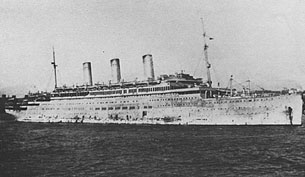SS Justicia

Justicia painted grey for wartime service.
|
|
| History | |
|---|---|
|
|
|
| Name: |
|
| Owner: |
|
| Operator: | White Star Line |
| Builder: | Harland and Wolff, Belfast |
| Yard number: | 436 |
| Laid down: | 1912 |
| Launched: | 9 July 1914 |
| Completed: | 7 April 1917 |
| In service: | 1918 as a troopship |
| Renamed: | Justicia |
| Fate: | Sunk after torpedoed six times on 19–20 July 1918. Four torpedoes were from UB-64, and two more torpedoes were from UB-124. |
| General characteristics | |
| Type: | Steamship |
| Tonnage: | 32,234 gross tons |
| Length: | 776 ft (237 m) |
| Beam: | 86 ft (26 m) |
| Propulsion: | triple expansion steam engines turning two outer propellers, plus an exhaust-steam turbine turning the centre propeller. |
| Speed: | 18 kn (21 mph; 33 km/h) |
| Capacity: | Intended passenger capacity of 3,430 people. |
| Troops: | Approximately 4,000 |
SS Justicia was a British troopship sunk during the First World War. She was laid down as SS Statendam, a 32,234 gross-ton ocean liner built for the Holland America Line by Harland and Wolff in Belfast. Before the ship was completed she was acquired by the British government and operated on behalf of the shipping controller by the White Star Line.
After several trips as a troopship she was torpedoed by a German U-boat off the British Isles in 1918 while sailing unladen.
Statendam was launched on 9 July 1914 and after her christening work began on fitting her for service. Before this could be completed, the First World War broke out and work stopped for one year. In 1915 the British government requisitioned Statendam for use as a troopship. The ship was at first given to the Cunard Line to manage because of the sinking of Lusitania, and the ship was renamed Justicia (Latin for justice) because of their traditional ship suffix -ia. Cunard had difficulty in assembling a crew for Justicia, so the ship was reassigned to the White Star Line, who had the crew of the sunken Britannic available. The ship’s grey hull was repainted in a dazzle camouflage scheme, and she went on to transport troops successfully.
On 19 July 1918 Justicia sailed unladen from Belfast to New York escorted by destroyers. While 23 miles south of Skerryvore, Scotland, she was torpedoed by the German Type III Coastal U-boat UB-64, under the command of Otto von Schrader. Justicia took on a list but the watertight doors were closed in time, temporarily preventing her from sinking. UB-64 then fired two more torpedoes at Justicia, striking her side. A fourth torpedo struck the wounded Justicia but she still remained afloat. The escorts were able to damage UB-64, which departed the area, while radioing in Justicia's position. Most of the crew were evacuated, leaving only a small number on board. Justicia's engines were still operable and the tug Sonia took her in tow, in an attempt to beach the stricken ship at a suitable location near Lough Swilly.
...
Wikipedia
